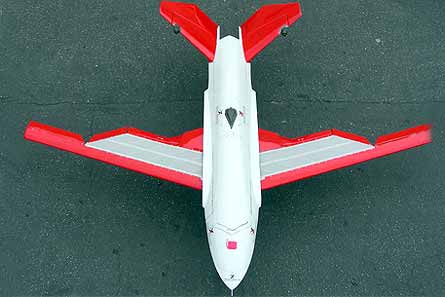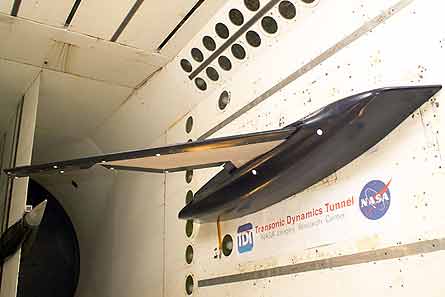The first in-flight demonstration of a shape-changing, or morphing, wing has been accomplished by small US company NextGen Aeronautics.
The test was in part of a US research programme to demonstrate an unmanned "hunter-killer" combining the loiter endurance of a surveillance platform with the high-speed dash of an attack aircraft in a single shape-changing vehicle.
NextGen, with funding from Boeing's Phantom Works research arm, demonstrated its flexible-skin morphing wing in flight on 1 August, using a subscale remotely piloted vehicle called the MFX-1 (pictured below with red wings). Changes in area of 40% and span of 30%, with sweep varying from 15° to 35°, were achieved in flight at speeds of 100-120kt (185-220km/h).
Torrance, California-based NextGen says the flights, at the Camp Roberts test range in California, were the first of a wing whose area, chord, sweep and aspect ratio can be changed in flight. Unlike a conventional variable-geometry wing, which reduces aspect ratio by "hiding" area inside the fuselage as it sweeps back, NextGen's morphing wing can change area independently of sweep by extending or reducing chord.
 |
|---|
 |
The US Defense Advanced Projects Agency's (DARPA) morphing aircraft structures programme aims to demonstrate technology to combine in a single design the increased loiter efficiency of a high aspect-ratio wing with the reduced high-speed drag of a low aspect-ratio wing.
Low-speed flights of the jet-powered MFX-1 followed successful tests of a larger version of NextGen's morphing wing in a NASA transonic windtunnel (pictured above) at speeds up to Mach 0.92. The wing has flexible, stretchable skin panels attached to an articulated lattice stucture with actuators in the joints. "We showed we could morph within 15s," says NextGen president Jay Kudva.
Whereas area and sweep could be controlled independently in the windtunnel, the radio-control model tests were limited to a single "degree of freedom" to demonstrate the skin's ability to change shape in flight, says Kudva, explaining: "When we swept the wing, area increased."
The morphing flight followed earlier tests of the 45kg (100lb) radio-controlled aircraft with the wing fixed - not all of them successful. "We had an unconventional landing and an unconventional take-off," says Kudva, adding "it had more to do with procedures" as the pilot flew remotely by watching the vehicle. A cheap, wrongly calibrated pitot tube did not help, and a laser gun was used to measure speed on the successful flight.
NextGen ultimately succeeded where Lockheed Martin failed, its Skunk Works abandoning plans to fly a morphing-wing UAV after two crashes during take-off attempts. DARPA says the crashes were caused by problems with the autonomous vehilce's flight control software. In Lockheed's morphing design the wing folds upwards and inwards, reducing area and increasing sweep as the inner section folds flat against the fuselage side.
Both contractors have been funded to build and fly more-powerful morphing-wing UAVs for the next phase of the DARPA programme, details of which are revealed in this week's Flight International magazine. This phase will demonstrate aggressive manoeuvring using fast morphing. NextGen's 90kg MFX-2 is due in the windtunnel in November and is to fly in January. The semi-autonomous UAV will be powered by two 50lb-thrust (225N) jet engine and will be capable of independently changing sweep and area, says Kudva.
Source: FlightGlobal.com



















